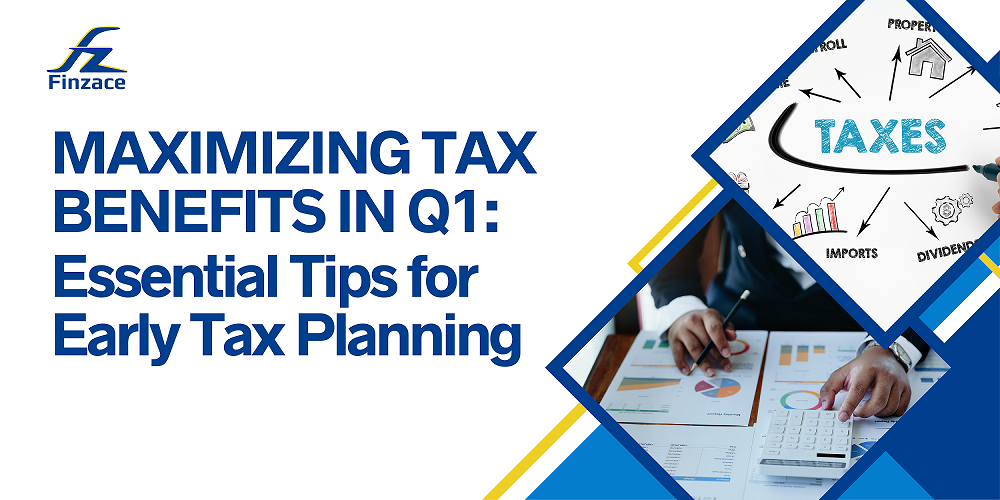The first quarter (Q1) of the year presents a unique opportunity for taxpayers. While the tax filing deadline might seem far off, taking proactive steps in Q1 can significantly reduce your tax burden come April. This blog delves into essential tips for early tax planning, enabling you to maximize your tax benefits and keep more money in your pocket.
Understanding Your Tax Situation
Before diving into specific strategies, it’s crucial to understand your current tax situation. Gather all relevant documents, including:
- W-2s: These forms report your income from employers.
- 1099s: These forms report income from miscellaneous sources like freelance work or interest earned.
- Deductions and credits documentation: Keep receipts and records for potential deductions and tax credits.
Analyzing Your Income and Expenses
Once you have your documents, categorize your income and expenses. Here’s a breakdown:
- Income: This includes wages, salaries, tips, investment income, and any other taxable income you received.
- Deductions: These are expenses you can subtract from your taxable income, lowering your tax liability. Examples include mortgage interest, charitable contributions, state and local taxes, and some business expenses for self-employed individuals.
- Tax Credits: Unlike deductions, credits directly reduce the amount of tax you owe. Common credits include the earned income tax credit (EITC), child tax credit, and dependent care credit.
Q1 Tax-Saving Strategies
Knowing your tax picture, you can leverage several strategies in Q1 to maximize your benefits:
1. Contribute to Retirement Accounts:
- Traditional IRA: Contributions to a traditional IRA are tax-deductible, significantly reducing your taxable income for the year. The contribution deadline for the previous tax year often falls in Q1 (April 15th for 2023 filings as of March 2024).
- Roth IRA: Contributions to a Roth IRA aren’t tax-deductible, but qualified withdrawals in retirement are tax-free. Consider if a Roth IRA aligns with your long-term financial goals.
- 401(k) or 403(b): If your employer offers a retirement savings plan, maximize your contributions if possible. Many companies offer matching contributions, essentially free money boosting your retirement savings.
2. Review and Adjust Withholdings:
Check your W-4 (for employees) or Estimated Tax Payments (for self-employed individuals) to ensure you’re withholding the appropriate amount. Overwithholding means the government holds onto more of your money throughout the year than necessary. You can adjust your withholding by submitting a new W-4 or adjusting your estimated tax payments. However, under-withholding can lead to penalties at tax filing time.
3. Accelerate Deductions:
Try to bunch some deductions into Q1. Examples:
- Charitable Contributions: If you plan on making substantial donations to charities, consider doing so in Q1 instead of spreading them throughout the year.
- Medical Expenses: If you anticipate large medical expenses, ensure you have the documentation for Q1 tax deductions.
- Business Expenses: Self-employed individuals should keep meticulous records of business expenses incurred in Q1.
4. Harvest Tax Losses:
Tax-loss harvesting involves selling investments at a loss to offset capital gains from other investments. This strategy can help reduce your taxable income in Q1, especially if you have investment accounts outside of retirement plans. However, consult a financial advisor to understand the implications before selling investments.
5. Consider Tax-Efficient Investments:
- Municipal Bonds: Interest earned on municipal bonds is generally exempt from federal income tax and may be exempt from state and local taxes depending on your location.
- Health Savings Account (HSA): HSAs allow you to contribute pre-tax dollars to cover qualified medical expenses. Unused funds roll over year after year, offering tax benefits throughout your life.
Additional Tips:
- Maximize Employer-Sponsored Benefits: Explore tax-advantaged benefits offered by your employer, like dependent care FSAs or health insurance plans.
- Review Tax Brackets: Be aware of your tax bracket and the income thresholds. Strategies like maximizing deductions or accelerating income can move you into a lower tax bracket.
- Stay Organized: Keep all tax documents organized throughout the year for a smooth tax filing process.
Seeking Professional Help:
Tax laws can be complex, and the best strategy for maximizing your tax benefits can vary depending on your circumstances. Consider consulting a tax professional for personalized advice, especially if you have a complex tax situation or own a business.
Conclusion
By taking advantage of these early tax planning strategies in Q1, you can significantly reduce your tax burden and gain peace of mind knowing you’re on track for a smooth tax filing season. Remember, the earlier you start, the more time you have to optimize your tax situation and potentially maximize your refund!
Finzace your Superhero For Setting Your Financial Goals
Finzace is a financial investment tool where you get high return fixed income investment opportunities in India. It is one of the best investment applications where you can invest yourself with ease. Finzace offers secured investment options where you get fixed-income assets, diversification, skilled management, low minimum investment, regulation, low volatility, and investing in government securities. These factors make Finzace an ideal investment option for those looking for low-risk investments and serve to reduce the likelihood of loss. It also provides the best low-risk investment options in India!
Just download the app and get the best fixed-return investment in India for you. We provide you with investing choices that are backed by research and assets, taking care of all the work for you. Get low-risk investment options in India today!
Download link (Android): https://play.google.com/store/apps/details?id=icreditspace.com
Download link (iOS): https://apps.apple.com/in/app/finzace-earn-12-returns/id6446245952

